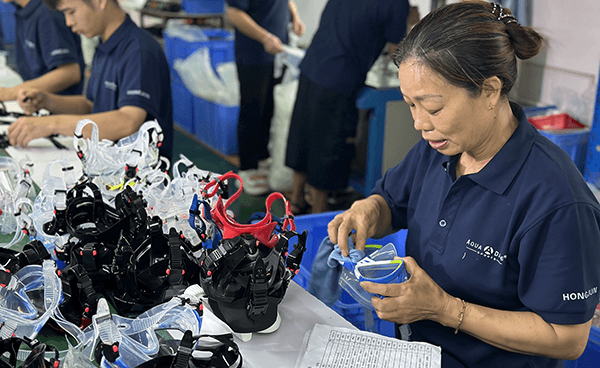Introduction
Diving is an exhilarating and adventurous activity that allows individuals to explore the wonders of the underwater world. Whether you are a professional diver or an enthusiastic hobbyist, having reliable and safe diving equipment is of utmost importance. One crucial component of diving gear is the use of silicone materials. Silicone is a versatile and widely used material in the manufacturing of various diving equipment such as masks, snorkels, and fins. In this article, we will delve into the safety aspects of silicone materials in diving equipment, exploring their benefits, potential risks, and the measures taken to ensure user safety.
Understanding Silicone
Before we dive into the safety aspects of silicone in diving equipment, let’s first understand what silicone is. Silicone is a synthetic polymer made from silicon, oxygen, carbon, and hydrogen. It is known for its flexibility, durability, and resistance to extreme temperatures. Silicone is widely used in various industries, including medical, automotive, and electronics, due to its unique properties.
Food Grade Silicone
Food grade silicone is a silicone material that has been specially treated to meet food safety standards for food contact applications. Identifying the standards and characteristics of food grade silicone can be done in the following ways:
Certification Marks
Food-grade silicone is usually labeled with relevant certification marks on the product, such as FDA (U.S. Food and Drug Administration) certification, LFGB (German Codex for Food, Beverages and Cosmetics) certification, and EU certification for food contact materials. These certification marks indicate that the silicone material meets the food safety standards of the respective country or region.
Color and Transparency
Food-grade silicone is usually transparent or translucent, lighter in color, we will add natural pigments to color in the production of different colors of scuba diving mask..
Odor and taste
Food-grade silicone should have no odor or chemical taste and will not release any harmful gases or volatiles. You can check for odor or taste by smelling or licking it with your tongue.
Hardness and Flexibility
Food-grade silicone is usually moderately hard and flexible, providing a good seal and comfort during use. When touched, food-grade silicone should feel soft, smooth and flexible.
Safety certification documents
Legitimate food-grade silicone manufacturers will provide appropriate safety certification documents, such as food contact material certification, Reliable manufacturers often adhere to standards such as ISO 9001. chemical composition analysis report, etc.. Consumers can request these documents from the manufacturer to ensure the safety of the product.
Benefits of Silicone in Diving Equipment
Silicone offers several advantages when used in diving equipment. Let’s explore some of the key benefits:
- Flexibility and Comfort: Silicone is a highly flexible material that can easily conform to the shape of the diver’s face or body. This ensures a comfortable fit, reducing the chances of discomfort or pressure points during prolonged diving sessions.
- Water Resistance: Silicone is inherently water-resistant, making it an ideal choice for diving equipment. It does not absorb water, preventing the growth of bacteria or mold that could potentially affect the user’s health.
- Durability: Diving equipment is exposed to harsh underwater conditions, including saltwater, UV radiation, and physical impacts. Silicone exhibits excellent durability, ensuring that the gear can withstand these challenging environments without compromising its integrity.
- Chemical Resistance: Silicone is resistant to a wide range of chemicals, including solvents, oils, and cleaning agents. This makes it easier to clean and maintain diving equipment, ensuring its longevity.
- Hypoallergenic Properties: Silicone is hypoallergenic, meaning it is less likely to cause allergic reactions or skin irritations. This is particularly important for individuals with sensitive skin who may be prone to allergic reactions to other materials.
Safety Considerations
While silicone offers numerous benefits, it is essential to address any potential safety concerns. Here are some key considerations:
- Quality Control: To ensure the safety of silicone diving equipment, manufacturers must adhere to strict quality control standards. This includes using high-quality silicone materials that are free from contaminants or impurities that could pose health risks.
- Certifications and Standards: Reputable diving equipment manufacturers comply with industry standards and certifications. Look for products that meet recognized standards such as ISO (International Organization for Standardization) or EN (European Norm) to ensure the equipment’s safety and reliability.
- Regular Inspection and Maintenance: Divers should regularly inspect their equipment for any signs of wear or damage. This includes checking the condition of silicone components such as masks and snorkels. If any issues are detected, it is crucial to replace or repair the equipment to maintain safety standards.
- Proper Cleaning and Storage: Cleaning diving equipment after each use is essential to prevent the buildup of bacteria or contaminants. Follow the manufacturer’s guidelines for cleaning and storage to ensure the longevity and safety of the silicone components.
- Allergic Reactions: While silicone is generally hypoallergenic, individuals with known allergies should exercise caution. If you have a history of silicone allergies, it is advisable to consult with a medical professional before using silicone-based diving equipment.
Frequently Asked Questions (FAQ)
5.How often should I replace silicone diving equipment?
The lifespan of diving equipment can vary depending on usage, maintenance, and environmental factors. It is recommended to follow the manufacturer’s guidelines for replacement intervals and regularly inspect the equipment for any signs of wear or damage.
4.What should I do if I suspect an allergic reaction to silicone diving equipment?
If you experience any signs of an allergic reaction, such as itching, redness, or swelling, discontinue use immediately and seek medical advice.
3.Are there any age restrictions for using silicone-based diving equipment?
Age restrictions may vary depending on the specific equipment and local regulations. It is advisable to check with the manufacturer or a diving professional for age recommendations.
2.Can silicone diving equipment be used in saltwater environments?
Absolutely! Silicone is highly resistant to saltwater and can withstand the corrosive effects of saltwater environments.
1.Is silicone safe for prolonged skin contact during diving?
Yes, silicone is considered safe for prolonged skin contact during diving. It is hypoallergenic and does not typically cause skin irritations or allergic reactions.
Conclusion
Silicone materials play a vital role in ensuring the safety and performance of diving equipment. Their flexibility, water resistance, durability, and hypoallergenic properties make them an excellent choice for divers of all levels. However, it is essential to prioritize safety by choosing high-quality silicone products, adhering to maintenance and inspection routines, and being aware of any potential allergic reactions. By following these guidelines, divers can enjoy their underwater adventures with confidence, knowing that their silicone-based diving equipment is both reliable and safe.
Remember, when it comes to diving equipment, safety should always be the top priority. So, before you embark on your next underwater expedition, make sure to equip yourself with reliable and well-maintained silicone gear. Happy diving!





